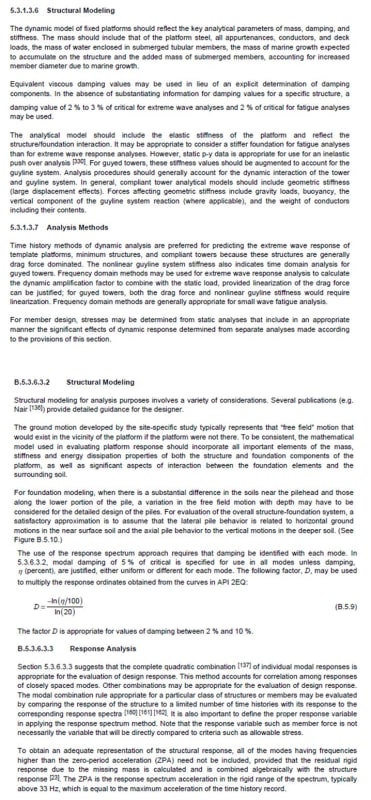WARose
Structural
- Mar 17, 2011
- 5,594
The situation: I have been asked to review a design for seismic and wave loading criteria by a engineering firm.
Job description: A steel structure supported on a heavy reinforced concrete mat, that is supported by reinforced concrete piles (about 4' in diameter), that cantilever up from the MWL (Mud Water Line) at heights varying from 25' to 50'. The piles are spaced at about 24' on centers. According to a outside consultant (who was asked about max. wave case, scour, max water height, etc.), the water height will never reach the mat. (Even in a worse case storm.) The "outside consultant" gave us worse case wave crest height and period. (Based on fetch, worse case storm wind velocity, etc.)
My concern: The FEA model (as it stands now) only has the static/breaking wave load (as per ASCE 7-10) inputted. It's like this thing is sitting in air: there is no accounting for the fact it is sitting in water. I think we need to go a bit deeper in separate cases. For the seismic case, since the SDC is forcing a modal analysis (should have mentioned that before), I think we need to be as accurate as possible to capture the behavior of it being in water. For the wave load case, the fact that a dynamic analysis shows that the structure has natural periods (with the majority of the mass participating) at just about the same period as the wave loading given by the "outside consultant"....makes me think a time-history analysis is in order here.
My Questions (in bold):
1. The forcing functions for most wave loading applications I have found are just to complicated to input (as is) into the FEA software I have. Therefore, I was thinking of working up the force applied as a function of time, and inputting that as a (simplified) sinusoidal function. Or perhaps just putting in the raw force vs. time that the equations yield. (Which I can do with my software.) Does this seem like a reasonable approach to you?
2. I am uncertain as to how to represent this thing sitting in the water. (I.e. the drag as it is setting into motion.) I was thinking about a multi-linear spring support. Any ideas as to the best way to represent this?
3. I usually specify damping by mode. In the modes that include the water drag (as it is set into motion).....what damping to consider? It will be a composite of the concrete pile stiffness (i.e. concrete damping) and the water dragging. But I don't have a clue on the water part. What would you specify for damping for the water drag?
Job description: A steel structure supported on a heavy reinforced concrete mat, that is supported by reinforced concrete piles (about 4' in diameter), that cantilever up from the MWL (Mud Water Line) at heights varying from 25' to 50'. The piles are spaced at about 24' on centers. According to a outside consultant (who was asked about max. wave case, scour, max water height, etc.), the water height will never reach the mat. (Even in a worse case storm.) The "outside consultant" gave us worse case wave crest height and period. (Based on fetch, worse case storm wind velocity, etc.)
My concern: The FEA model (as it stands now) only has the static/breaking wave load (as per ASCE 7-10) inputted. It's like this thing is sitting in air: there is no accounting for the fact it is sitting in water. I think we need to go a bit deeper in separate cases. For the seismic case, since the SDC is forcing a modal analysis (should have mentioned that before), I think we need to be as accurate as possible to capture the behavior of it being in water. For the wave load case, the fact that a dynamic analysis shows that the structure has natural periods (with the majority of the mass participating) at just about the same period as the wave loading given by the "outside consultant"....makes me think a time-history analysis is in order here.
My Questions (in bold):
1. The forcing functions for most wave loading applications I have found are just to complicated to input (as is) into the FEA software I have. Therefore, I was thinking of working up the force applied as a function of time, and inputting that as a (simplified) sinusoidal function. Or perhaps just putting in the raw force vs. time that the equations yield. (Which I can do with my software.) Does this seem like a reasonable approach to you?
2. I am uncertain as to how to represent this thing sitting in the water. (I.e. the drag as it is setting into motion.) I was thinking about a multi-linear spring support. Any ideas as to the best way to represent this?
3. I usually specify damping by mode. In the modes that include the water drag (as it is set into motion).....what damping to consider? It will be a composite of the concrete pile stiffness (i.e. concrete damping) and the water dragging. But I don't have a clue on the water part. What would you specify for damping for the water drag?

